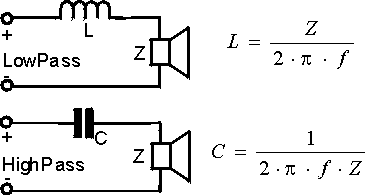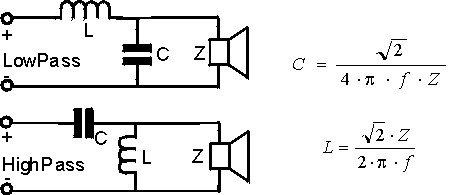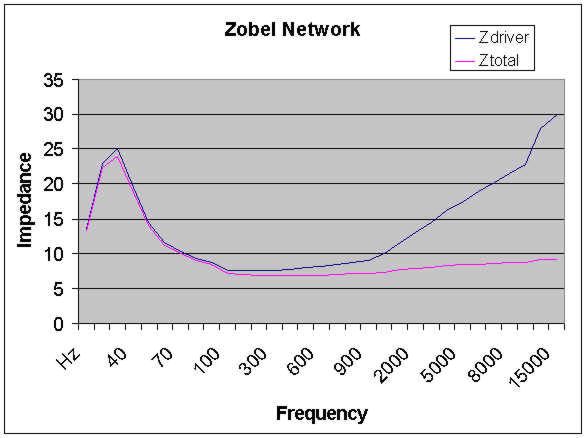
Back to home page
Back to audio main page
Back to loudspeakers main page
This is the simplest form and the better if your drivers don't need sharp cutoffs.
Phase rotation is the smallest of the various types.

This type has a sharper cutoff and still acceptable response.

If you need a sharp cutoff, this type is suited but phase rotation is higher than the previous types.

Often tweeters don't have the same efficiencies as woofers or mediums.
To match them, you must insert a resistive network on the most efficient drivers.
The second condition is the impedance should remain the same as the driver alone.
The divider network is inserted after the filter and before an eventual Zobel network.

Here are the values for R1 and R2 and a 8 Ohms driver.
For a 4 Ohms driver, divide each resistor value by 2.
For a 16 Ohms driver, double the resistors values.
dB |
R1 |
R2 |
0.5 |
1.72 |
29.11 |
1 |
2.35 |
19.25 |
1.5 |
2.80 |
14.86 |
2 |
3.16 |
12.22 |
2.5 |
3.47 |
10.42 |
3 |
3.75 |
9.08 |
3.5 |
3.99 |
8.04 |
4 |
4.21 |
7.20 |
4.5 |
4.41 |
6.50 |
5 |
4.60 |
5.91 |
5.5 |
4.77 |
5.40 |
6 |
4.94 |
4.96 |
6.5 |
5.09 |
4.57 |
7 |
5.23 |
4.23 |
7.5 |
5.37 |
3.92 |
8 |
5.50 |
3.64 |
8.5 |
5.62 |
3.38 |
9 |
5.74 |
3.16 |
9.5 |
5.85 |
2.95 |
10 |
5.95 |
2.75 |
Boomers and some mediums have an impedance that rises a lot at high frequencies.
To maintain this impedance at reasonable values a Zobel network is used.
It should be placed right before the driver.

Example with a 6.8uF and a 12 Ohms:

Download (Excel 7.0 32bits)
Download (Excel 4.0 16bits)